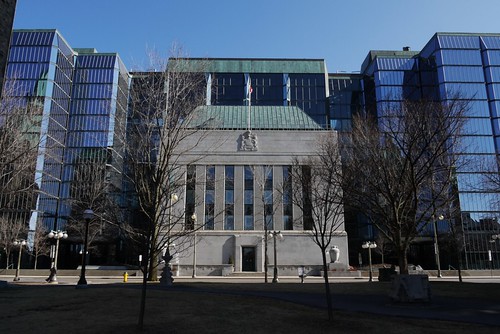Bank of Canada Holds Rate at 5%, Says Too Early to Talk Cuts
Bank of Canada #BankofCanada

(Bloomberg) — The Bank of Canada held its policy rate steady for a fifth consecutive meeting, acknowledging progress on inflation while reiterating that it’s still “too early” to consider rate cuts.
Most Read from Bloomberg
Policymakers led by Governor Tiff Macklem left the benchmark overnight rate unchanged at 5% on Wednesday. The pause was expected by markets and by economists in a Bloomberg survey.
Officials say there have been “no big surprises” in economic data in the six weeks since their January decision, when they indicated the discussions were shifting to how long borrowing costs need to stay at the current level.
“Today’s decision reflects governing council’s assessment that a policy rate of 5% remains appropriate. It’s still too early to consider lowering the policy interest rate,” Macklem said in prepared text of his opening statement.
The Canadian dollar rallied to a one-week high after the decision and was trading at C$1.3535 per US dollar at 10:15 a.m. in Ottawa. The benchmark Canada two-year bond pared earlier gains, but the yield remained about 2 basis points lower on the day at 4.025%.
In the policy statement accompanying the rate decision, the bank left the last paragraph intact with no changes, keeping the line: “The council is still concerned about risks to the outlook for inflation, particularly the persistence in underlying inflation.”
Macklem’s comments and the few changes to the statement suggest policymakers aren’t yet convinced inflation is on a sustained path to their 2% target, and still want to see more progress on price pressures before they can start cutting interest rates from restrictive levels.
Story continues
Dawn Desjardins, chief economist at Deloitte Canada, said the central bank is pushing back against expectations that rate cuts are imminent. “I think they really want people to be aware that, yes, they’re going to come, but we need to see a true path to 2%,” she said on BNN Bloomberg Television.
“Recent inflation data suggest monetary policy is working largely as expected. But future progress on inflation is expected to be gradual and uneven, and upside risks to inflation remain,” Macklem said.
‘Excess Supply’
Still, officials say they’re seeing “some signs” that wage pressures are easing and noted that employment gains are lagging population growth. And while the economy grew by more than expected at the end of last year, the bank called the pace of growth “weak and below potential.”
“Overall the data point to an economy in modest excess supply.”
The governor and Senior Deputy Governor Carolyn Rogers will expand on their thinking when they speak to reporters at 10:30 a.m. Ottawa time.
Before Wednesday’s decision, traders in overnight swaps were betting the bank would start cutting borrowing costs by the July meeting. Economists see June as the more likely start to the easing cycle.
“The BOC has the luxury to wait until it sees more progress on inflation before starting to ease its policy rate,” said Dominique Lapointe, director of macro strategy for Manulife Investment Management. The economy may continue to weaken in the first half of the year, and “if that happens, the BOC would be in a position to signal a shift towards easing at the April meeting, preparing markets for a June cut.”
The bank’s next rate decision is on April 10, when policymakers will also update their economic projections after getting new information on corporate pricing behavior and inflation expectations.
The country’s labor market is weaker than it was a year ago. The yearly change in the consumer price index decelerated to 2.9% to start the year, just the second time in 34 months that price pressures have fallen below the 3% cap of the bank’s target band.
In the statement, the bank reiterated that elevated shelter prices are the biggest contributor to inflation, and noted that yearly and three-month measures of core price pressures are stuck in the 3% to 3.5% range.
“We don’t want to keep monetary policy this restrictive longer than we have to,” Macklem said. “But nor do we want to jeopardize the progress we’ve made in bringing down inflation.”
–With assistance from Jay Zhao-Murray and Carter Johnson.
(Updates with market reaction in fifth paragraph, economist comments and chart.)
Most Read from Bloomberg Businessweek
©2024 Bloomberg L.P.